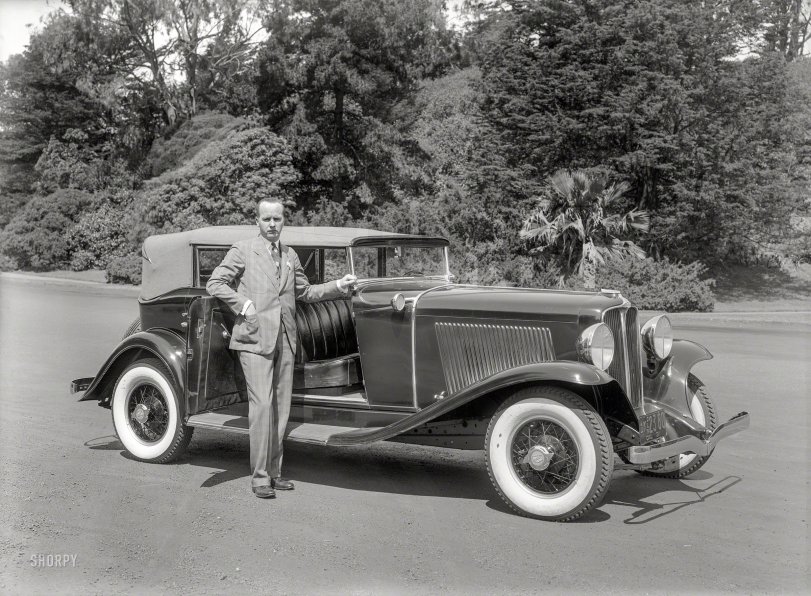


Framed or unframed, desk size to sofa size, printed by us in Arizona and Alabama since 2007. Explore now.
Shorpy is funded by you. Patreon contributors get an ad-free experience.
Learn more.

- Freeze Frame
- Texas Flyer wanted
- Just a Year Too Soon
- WWII -- Replacing men with women at the railroad crossing.
- Yes, Icing
- You kids drive me nuts!
- NOT An Easy Job
- I wonder
- Just add window boxes
- Icing Platform?
- Indiana Harbor Belt abides
- Freezing haze
- Corrections (for those who care)
- C&NW at Nelson
- Fallen Flags
- A dangerous job made worse
- Water Stop
- Passenger trains have right of way over freights?
- Coal
- Never ceases to amaze me.
- Still chuggin' (in model form)
- Great shot
- Westerly Breeze
- For the men, a trapeze
- Tickled
- Sense of loneliness ...
- 2 cents
- Charm City
- What an Outrage
- Brighton Park
Print Emporium
Uneasy Rider: 1931

San Francisco, 1931. "Auburn at Golden Gate Park." Similar to the car seen earlier here. 5x7 inch glass negative by Christopher Helin. View full size.
Heterogeneity
Not readily visible in the photo are the contrasting colors that were in vogue on the 1931 Auburns. The photos below provide much more vivid illustrations of the blatant color schemes available. One of the people assisting the design staff was Count Alexis de Sakhnoffsky who was known for his use of extravagant color schemes. He was, at the same time, also the body designer of the more subtlety colored DeVaux cars seen here.
The Auburn shown is a model 8-98A Custom Phaeton Sedan which cost $1,345 and weighed 3,700 pounds. The freshly styled Auburns were three inches lower than the previous year which was possible by the use of underslung semi-elliptic springs and 17 inch wheels. The bumper with the drop in the center was a covert allusion to the reduced height of all Auburn models. The windshield on this model could fold down over the cowl. Safety glass was optionally available, but radios from the factory were still not offered.
This was Auburn's best year for sales with 32,301 cars produced, and the firm rose from 22nd place in the industry in overall sales to 13th place. It was the only time Auburn broke into the top 20 of U.S. automobile manufacturers. Sales would fall more than 64% in 1932. Auburn production finally ended in August of 1937. The rights, tooling, castings, etc. for the V-12 engine Auburn brought out in 1932 were purchased by American LaFrance, improved, and then utilized in their smaller fire trucks until 1963.
Re: Re: Knockoff Hubs
Back in the day I owned a 1962 MGA 1600 MkII equipped with wire wheels with knockoff hubs. Rather than wood or leather, the mallet had a solid copper head to avoid damaging the hubs. Wish I had that car today.
Re: Knockoff Hubs
You used the hammer on the flat side of the 'wings' to loosen the hub (hence, 'knockoff'); the threads on the hub tightened with the rotation of the wheels when the car was moving forward, so the hubs only needed to be hand tightened, with maybe a love tap or two from the hammer. The hammer, incidentally, was wood or leather, to avoid damaging the hubs.
Auburns looked so great!
Like many teens of my generation, I first became aware of Auburns and Cords when Olds introed the Toronado, which hit me (as Nicky-Nick-Nick would say) "Like the hot kiss at the end of a wet fist."
My wife and I are shopping right now for what will likely be our last new car, and they all look like bars of soap.
Knockoff Hubs
Wheels, use a hammer to spin the hub cover. If you look carefully, you can see the arrows on the front wheels hubs that indicate which direction they spin. Auburn was quite sporty. This example is interesting in how the height of the windscreen is used to make car look bigger.
Hubcaps
How did they get them off. They are only flat on one side to pound them on/ tighten them. You would have to hit on an angle to loosen them.
That gentleman needs a shoeshine
Then there would be a smile in his heart--even if the scowl on his visage remained the same.
Serial Numbers
Note that they are both dealer plates. I'd be happy with either car today.
Not an easy clean.
Imagine crawling underneath That Auburn to scrub those B.F. Goodrich double whites.
Similar, but Different
The earlier Auburn is a sedan with a canvas covered roof. This one's a convertible.
[So it is! I thought they had the same tag number, but not quite. -Dave]
Worrywart
The guy looks a lot like Bob Crosby on a bad day.
Offhanded
He should have had the stitches holding his pocket closed removed before he posed for the picture. He would then have been able to get his whole hand into it!
























On Shorpy:
Today’s Top 5